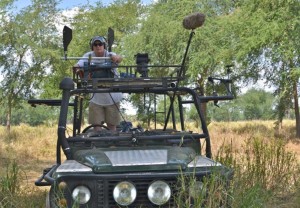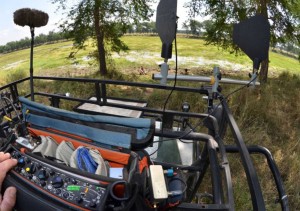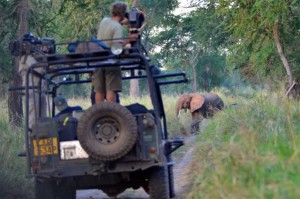
In order to record audio for War Elephants, which aired this month, Ruddick joined Dr. Joyce Poole, an elephant behavior expert, and her brother Bob Poole, a wildlife cameraman for National Geographic, to help re-establish safe tourism in the park now that the country’s civil war has ended and ivory poaching has recently abated.
For the documentary, Bob Poole rebuilt a Land Rover and made an “elephant proof roll cage” to help prove he and his sister’s theory, that the Gorongosa elephants could learn that not all humans in vehicles visiting the park are bad. The theory was that when a vehicle encounters a group of elephants, instead of driving away or honking a horn or screaming in fear as an elephant charges, you hold your ground and try to stay calm. When the elephants learn that the vehicle and people inside are not a threat, they will go about the business of being elephants, and not chasing safari tourists every time they see them. The theory worked, but there were a lot of tense moments and close calls involved in proving it.

“The film presented many obstacles for recording great dialog,” said Ridduck. “Relying on wireless transmission from the hero car to my vehicle and also sending a stereo mix to the camera, and driving at the same time could get very challenging. When we were filming elephants, we had to position the sound vehicle in just the right place to have good wireless range and be out of the shot, and leaving an escape route for the vehicle just in case we met a rogue elephant who wanted to smash the sound vehicle. I had a lot going on but having the 552 riding shotgun next to me made mixing and recording second nature. The 552 is built like a tank, sounds great and is always reliable in demanding situations, it didn’t miss a take.”
The 552 is designed to withstand the physical and environmental extremes of field production. It has a molded, metalized carbon fiber top and bottom chassis panels for increased durability and weight reduction. Additionally, its front panel is gasketed for improved resistance to moisture.
Another challenge Ruddick faced was Mozambique’s extreme temperatures and terrain. “This was one of those jobs where sound equipment took a beating,” Ruddick explained. “We drove over 1,500 kilometers on incredibly bumpy 4X4 roads, as well as driving down elephant paths, so anything that was not well made (including cars) fell apart. Temperatures were hot and dust was always a problem. The one piece of gear I could always count on was the 552.”

The 552 contains five high-dynamic-range transformer-balanced microphone inputs with expanded gain and headroom. Each input accepts audio sources of various types and levels. Inputs have their own limiter, sweepable high-pass filter, and pre-or-post-fade direct output.
The 552 has an integrated two-track, digital audio recorder writing standard Broadcast Wave files to SD and SDHC media. A joystick controller is used to take control of recording functions. Either WAV or MP3 files can be recorded. Recordings can be either 24 or 16 bit, with WAV files having sampling rates from 44.1 kHz up to 96 kHz.
With its three sets of balanced master outputs (plus numerous unbalanced connections), the 552 provides connectivity for multi-camera and complex production setups.
“There are many great features and qualities of the 552, but I really was impressed with just how fantastic it sounds,” said Ruddick. “Being able to record nice clean ambient sound directly on the 552 was very liberating. Having a perfect backup recording to synch dialog when things went wrong (and they went very wrong more than once) changed my whole outlook on direct-to-camera wireless recording. The director on this shoot was adamant that he wanted my best mix recorded to camera. I did what he asked but boy was I glad I had the back-up recordings when I found out that the wireless link had issues (broken cables and bumped levels, etc.)”





